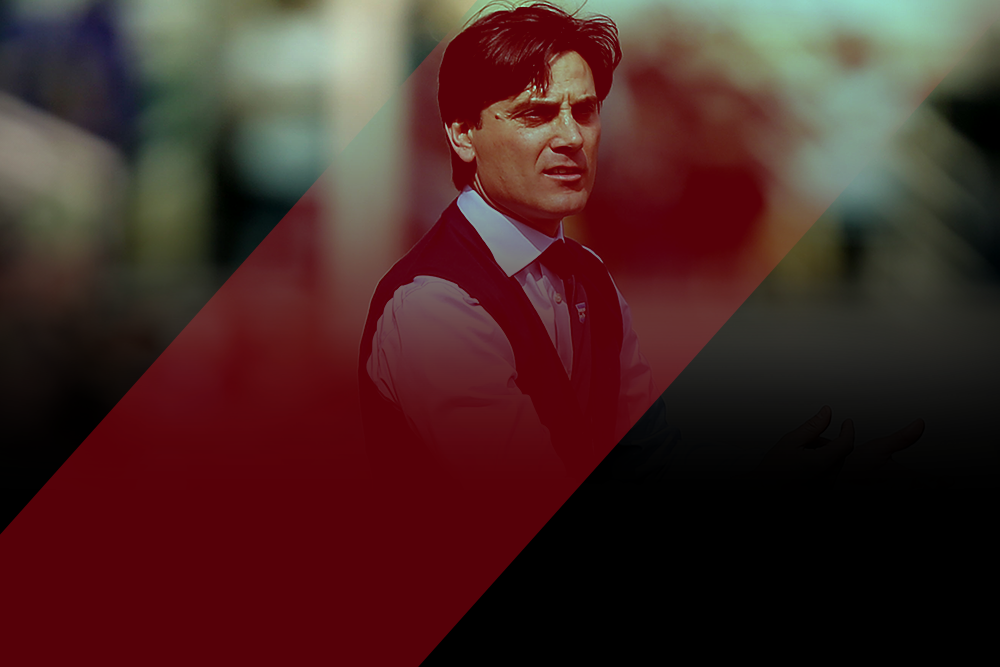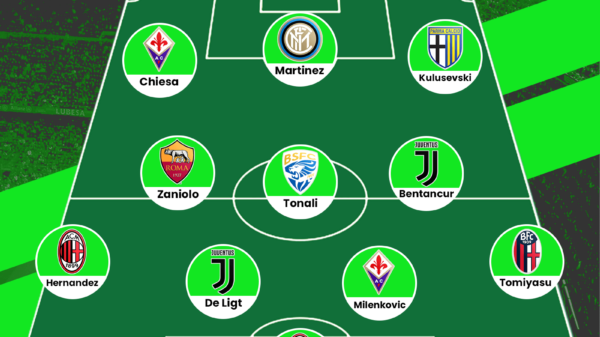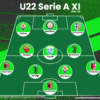
While this website has made its name focusing on the lesser known youth of this beautiful sport, and combined it with a tinge of tactical flavour meant for the football enthusiast, we found a large gap to be exploited in terms of combining the two. This mini-series thus focuses on young managers (below the age of 45) and their tactical philosophies, deriving what got them here and where they could go. Saiguhan Elancheran writes about one of the best young managers in the game today, Vincenzo Montella.

Background
Born in Castello di Cisterna, Italy, Montella has represented his country in 20 international games. He is nicknamed L’Aeroplanino, in reference to his small stature and trademark goal celebration, in which he spread his arms like wings.
Montella began his managerial career as Roma’s caretaker manager in 2011, later coaching Catania the following season. In 2012, he moved to Fiorentina, where he spent three seasons, leading the club to three consecutive fourth-place league finishes, the 2014 Coppa Italia Final, and the UEFA Europa League semi-finals in 2015. Despite a successful stint at La Viola, he was sacked as he failed to reach the Champions League spots and he was accused of lack of respect shown to the Fiorentina powers. The following season he joined Sampdoria before going on to join Milan in 2016.
Tactical Philosophy
Fiorentina
Vincenzo Montella is known for his intricate possession based play, which has given him some brilliant results in the recent past. In his three seasons at La Viola, Montella was adept in shifting between 4-3-3 and 3-5-1-1. His style of play is the reason. Midfielders were the main key to his success at the time. Borja Valero, David Pizarro and Alberto Aquilani formed the core of his squad.
Facundo Roncaglia, Stefan Savic and Gonzalo Rodriguez were all new recruits from Boca Juniors, Manchester City and Villarreal, respectively at the time he took in-charge. In the below image, we can see the back three spreading to cover the width of the field on attack. This gave the wing-backs encouragement to move forward and hug the touchline, while not having to worry about leaving gaping holes in the channels.
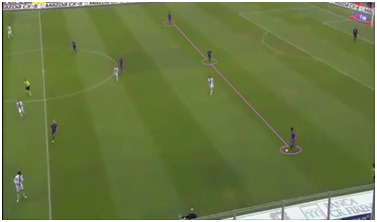
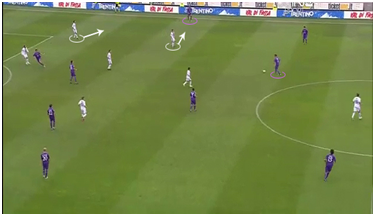
In the above image, we can see Juan Cuadrado, the right-wing-back, is able to push forward and commit two Atalanta players. This allows Rodriguez to step forward with the ball and look for a pass without being chased down immediately. In a three-man defence, the centre-backs are always encouraged to move forward, carry the ball and exert an attacking influence.
Fiorentina under Montella were scintillating to watch. The natural movements and the innate ability of the players to move into areas of space were well drilled. The midfield can often be crowded out, but Valero did well in getting the ball down and finding his two central-midfield partners. Aquilani’s form under Montella returned astutely from his time at Roma and David Pizarro’s ability to pick out a defence-splitting pass that can take a number of players out of the game was well used. This short-passing game had been the main focus for Montella to enforce onto the team. With his 4-3-1-2 and the 3-5-2, Montella always looked to overload the centre.
The three midfielders created triangles and passed the ball around the opposition midfield. With the overlapping runs of wing-backs Pasqual and Cuadrado, Fiorentina were asking questions to the opposition numbers. But there were certain weaknesses in this system. He often used attacking wingbacks in Cuadrado and Pasqual. This let the opposition to exploit the spaces left by them in turnovers.
AC Milan
It has been the same philosophy that Montella has played at Milan. But in Milan, he has favoured the de facto 4-3-3. The attacks usually begin from the centre backs. They pass between them and play long balls to the flanks if needed. The long balls are used to switch flanks and it is major aspect of Milan’s build up.
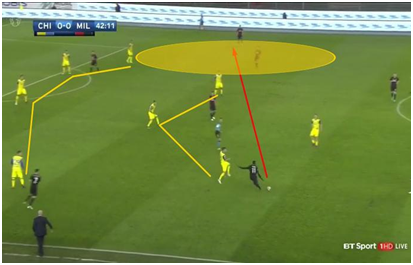
The above instant from the 3-1 win over Chievo is self-explanatory. The ball near winger plays the long ball to switch the play from one flank to another. This is quite repetitive in the current Milan side.
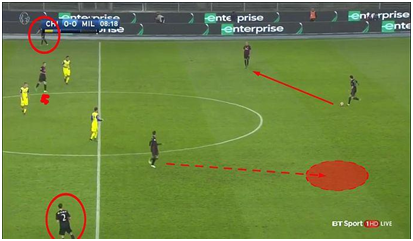
We can infer the style of playing out from the back in the above picture. Against Chievo, Alessio Romagnoli and Gabriel Paletta were the players who registered the most passes. When the two centre-backs have the ball possession, the two fullbacks bomb-up forward to join the attack. The CDM Locatelli between the two centre defenders creating a sort of three-man defence which is quite popular in a 4-3-3. This creates a situational 3-4-3 in attacking stages of the game.
In their 1-0 win over Juventus, Milan played with a more conservative 3-4-3 formation in the build-ups.
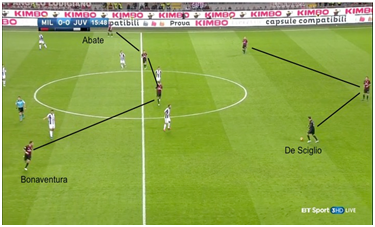
Often during the defensive stages, Kucka and Montolivio drop deep to help out the defence. This would prove decisive if they could effectively press and cut off passing lanes. Unfortunately, Montolivo doesn’t possess the physical characteristics for such a role anymore given his age and Kucka is having to do the pressing work of two midfield players, which is probably doing more harm than good. As a blessing in disguise, Montolivo’s absence has given Locatelli the chance to play in the team. And Locatelli has been acting as the shield for the back four in the absence of the old veteran very well.
Three career defining games
Fiorentina 4-2 Juventus: Fiorentina secured the European qualification in Montella’s first season by finishing in fourth place. But questions were raised whether he could continue that great run by performing well in the next season. Going into the month of October, Fiorentina faced the defending champions. The game was slipping away from La Viola as Juventus had taken a 2-0 lead before HT. It was Montella’s pep talk during the HT break and a change in shape for Fiorentina which did the trick. They came back after the break and scored 4 goals past the Juventus’ defence. This happened when the home side shifted to a back 4 from a back 3, which paved the way for them to press in a better manner with more width. This comeback win against the champions brought laurels to Montella as he proved how he was adept at reading the situation and turn the game upside down even against a tougher opponent like Juventus.
Milan 1-0 Juventus: Much was being spoken when Montella was appointed as the manager of Milan. The side has seen a variety of managers come and go and people started analysing how the players would adapt to Montella and vice versa. But so far the result of the appointment has been fruitful. In the third week of October, Milan faced the defending champions. Questions were raised about how Montella would make such a side to take anything out of the game against the champions of the league. But Montella drilled his side very well as they kept Juventus at bay throughout the game, maintaining complete discipline and capitalised on Juventus’ only mistake to score the goal. The win saw Montella receive plaudits as he proved to be a manager who could win the big games not just by controlling the game with offensive possession, but also with great defensive discipline.
Supercoppa Italiana Final: Juventus 1(3)-1(4) Milan: Juventus and Milan played each other in the super cup held at Doha. Juventus went into the game as heavy favourites as they looked to add their first silverware of the season. Giorgio Chiellini volleyed Juve into an 18th-minute lead at the Jassim Bin Hamad Stadium but Giacomo Bonaventura headed Milan level seven minutes before the break to leave the game level at 1-1 after extra-time. Mario Pasalic scored the winning penalty as Milan lifted the Supercoppa Italiana for the first time in five years with a 4-3 shootout victory over the holders Juventus in Doha. The result means Milan have now equalled the Turin club’s record of seven super cup wins. And most importantly, the win gave Montella his first silverware as a manager.
Three Key Players Developed
Stefan Savic: The Man City drop out who was sent as a part of the Nastasic deal proved to be a vital cog in Montella’s plans. Coming at the age of 21, Savic was a decent enough defender with raw abilities. Montella nurtured Savic to a player who would go on to become a regular starter in the side at such a young age. Savic made 86 appearances in three seasons for Li Viola.
Davide Calabria: At 20 years of age, Davide Calabria looks like the ideal replacement for 30-year old Abate. Calabria is one of Milan’s most promising youngsters along with Donnarumma and Locatelli. His work-rate and defensive awareness out of possession are just two positives that have already made him a favourite with the San Siro faithful.
Manuel Locatelli: After impressing current boss Vincenzo Montella in pre-season, Locatelli was included in Milan’s squad for the league and was given shirt number seventy-three. He was included in the bench for Milan’s first three league games, but was substituted into the game against Sampdoria in the fifty-seventh minute. Since then, Locatelli has featured in every league game Milan has played. Locatelli looks to be the ideal replacement for the veteran Montolivo. With Donnarumma alongside him, Locatelli looks to be the future of AC Milan.
Conclusion
After becoming a coach just at the age of 37, Montella has showed regular increase in gradation of his management and understanding to the game. He is the kind of manager who could do wonders with a small budget team. Milan made an astute decision in signing him as we could see the great results he has produced so far. His work in developing the youth has been amazing and he certainly is one of the best managers in the league at the moment. Having won his first silverware just before the end of the calendar year, he is definitely on the verge on adding more to his trophy cabinet. Vincenzo Montella is one manager to watch out for in the future.
Read all other articles of the series here.




















































